Spruce Up Your Home Gym with These Elite Floor Mats
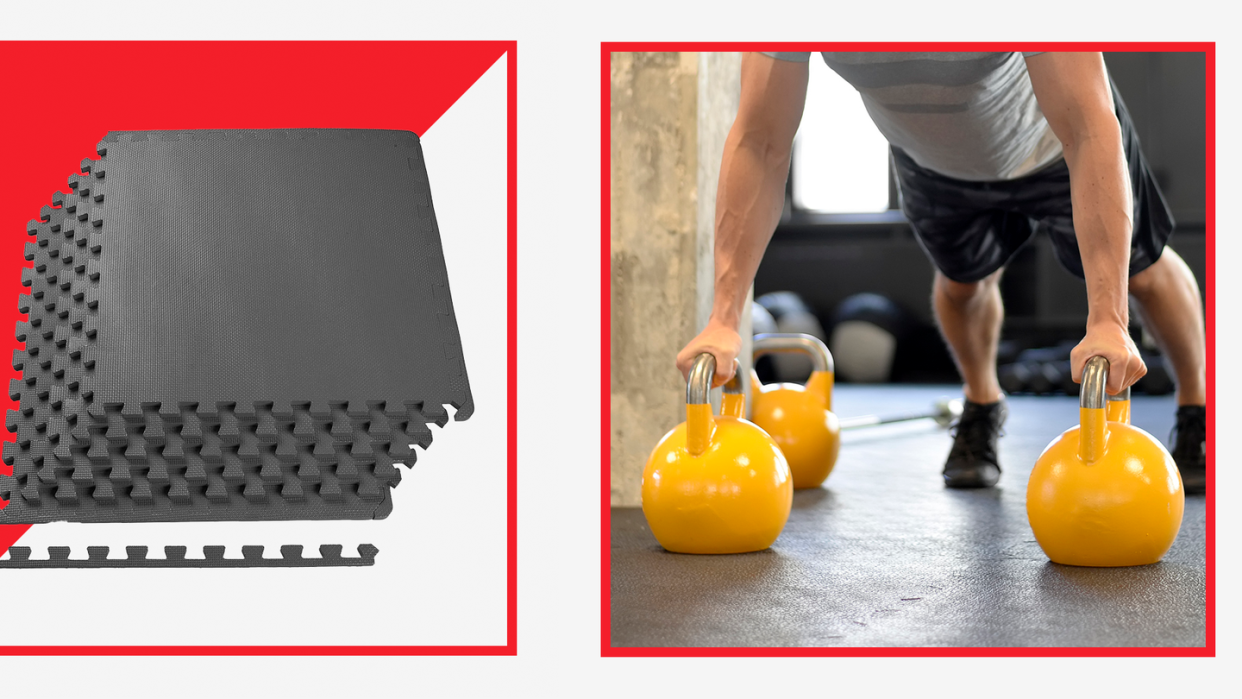
"Hearst Magazines and Yahoo may earn commission or revenue on some items through these links."
AN AT-HOME training space is not just a luxury for the rich and famous. It's a legit way of life. And creating a fully-stocked home gym is not only an investment, but an art. With so many home gym products on the market, there are endless decisions to make about what you need and what you don't. But there's one essential, yet often overlooked piece of equipment that can improve any home fitness experience: a quality gym-friendly floor.
[product-summary-view] stripped
Read more: How Men's Health Thoroughly Tests and Reviews Fitness Products
The best home gym floor mat for any workout space is professionally built and installed by a company like Thor Performance, which does everything from standard rubber flooring to turf. While using a company that focuses on building a custom setup that meets your aesthetic and performance goals is always the best route, the cost and commitment custom flooring requires isn't realistic for everyone. So, let us introduce you to the best home gym floor mats that can be installed and removed without a professional.
Depending on your current setup, you may just be using a yoga mat or whatever flooring is in your home. Technically, that works. But, trust us, there's a better way. If you want to elevate your home gym space, investing in one of the best home gym floor mats can seriously improve the setup.
Besides looking cool, the best home gym floor mats offer an extra layer of cushioning and grip. That functional (and ideally, non-slip) padding helps absorb some impact when lifting, going easier on the joints and providing a stable base for all types of training.
If you're worried about the scratches and scuffs your fitness routine may be inflicting on your home's floors, know that the best home gym floor mats can act as a helpful buffer, too. And, importantly in the era of WFH, the right flooring can even dampen noise associated with slinging weight around during your workout.
The best home gym floor mats are aligned with how you workout, how much you're willing to spend, how much floor space you need to cover, and your environment (flood-prone?, direct sunlight?, etc.) From rubber and foam to cork and turf, here are the best flooring options for your home workouts in 2024.
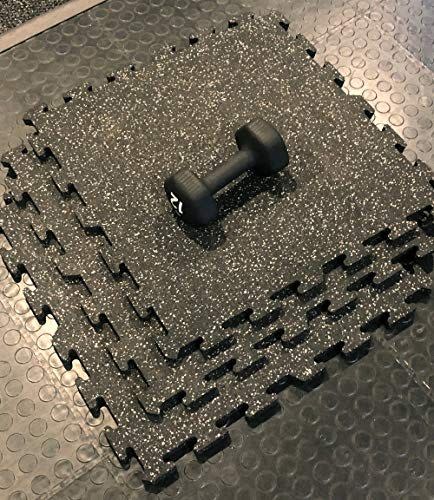
3/8-inch Thick Warrior Heavy-duty Rubber Flooring
amazon.com
$101.48
Courtesy of RetailerThere is a reason that heavy-duty rubber flooring is used in most commercial and next-level home gyms. The material is strong, sturdy, and resilient, making it ideal for any type of exercise or equipment. This ⅜-inch version is plenty thick for most home gyms, but other thicknesses are available if you want to dial in your preferred level of flooring. Either way, it fits right over your carpet, hardwoods, or most other surfaces, with each piece interlocking like a jigsaw puzzle. That means, unlike traditional flooring, “installation” is quick and painless (unlike walking down the stairs after leg day).
We especially like that the jigsaw-style installation means you can make this work in an odd-shaped room, and it’s also simple to move or remove entirely if you need to. In addition to solid black, this product is also available in a handful of other colors, so you can dress up your home gym space beyond the sterile, industrial “boxing gym” look. These are a little heavier and pricier than most, but for a commercial-grade product in your home, they’re one of the best options money can buy.
Read more: Best Incline Treadmills
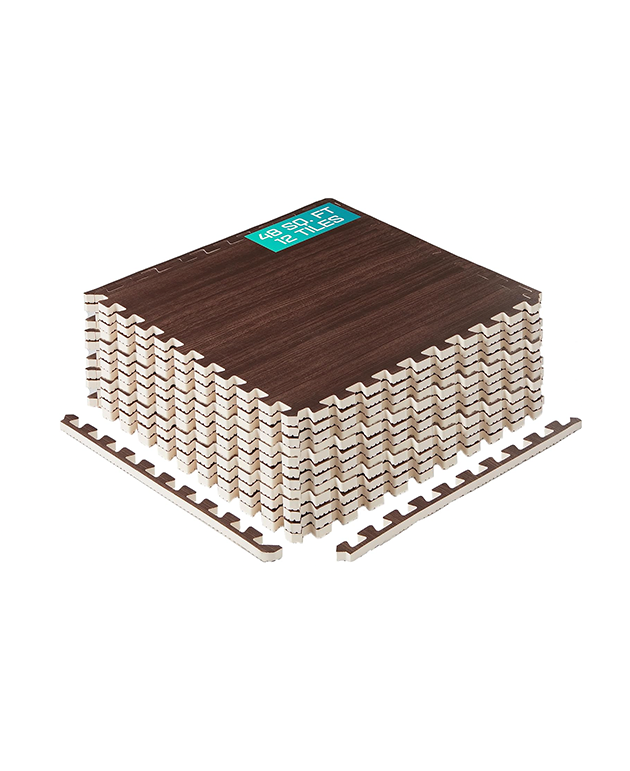
Interlocking Wood Grain Floor Mat Tiles
amazon.com
$44.99
Foam is hands-down the most comfortable option for floor-based workouts like yoga and Pilates (or for your final resting place after death by burpees). Excellent shock-resistance makes foam great for HIIT workouts too. Yes4All’s Wood Grain Floor Mats are reasonably durable and non-slip for a safer, more sure-footed workout than traditional foam flooring. The interlocking tiles are also extremely easy to install and remove. In most cases, either can be done in about five minutes, making them ultra-portable and practical even for renters. We also like that this model is available in a wide variety of wood grain prints, which add a touch of finesse to the foam aesthetic.
On the downside, foam lacks the same support for heavy weights or beefy home gym equipment as heavy-duty rubber gym flooring options. Power racks and weight benches can leave dents in foam mats over time and cause premature wear. But for cheap, easy-to-install gym flooring that can double as a play area in between doing supersets and being super dad, it doesn't get better than foam tiles. Plus, at roughly $1 per square foot, this model is a great value.
Read more: Best Folding Exercise Bikes
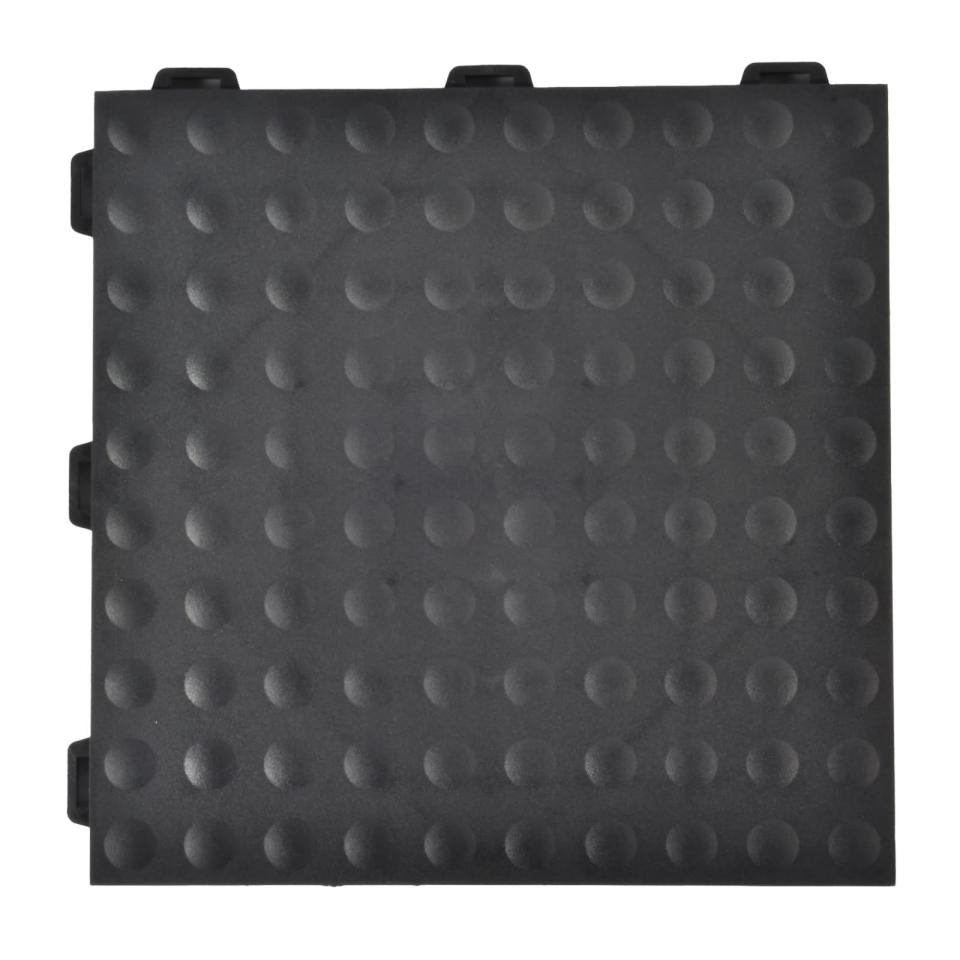
StayLock Bump Top Flooring Tile
amazon.com
$129.79
Vinyl is a practical choice for flooring because it can stand up to the abuse of a home gym yet it's comfortable and chic enough for a living space. Greatmats’ StayLock Floor Tiles are waterproof and resistant to mold, and mildew—all of which make it perfect for basement installations. Vinyl can even handle harsh cleaning chemicals to wipe up all your blood, sweat, and tears (but hopefully more sweat than blood). This is another jigsaw-puzzle-style model with a dead-simple installation process, as pieces interlock together in seconds. The best thing about interlocking tiles is that they don’t require an underlayment, so they install cleanly over carpeting, hardwoods, and cement floors with little prep beforehand.
On the other hand, vinyl is not as durable as heavy-duty rubber. The material can puncture and tear more easily, so save the samurai sword workouts for the dojo. It also lacks the same cushiony “give” of foam floor pads, so it’s not ideal for floor-based workouts like yoga and Pilates (or acrobatics, if that's your thing). Vinyl flooring may also pose a risk from off-gassing emissions for those with sensitive respiratory systems, which is a factor to consider before purchase. If you have a well-ventilated space and need a decent, easy-to-install budget flooring option for your home gym, this is a sound option.
Read more: Best Rowing Machines
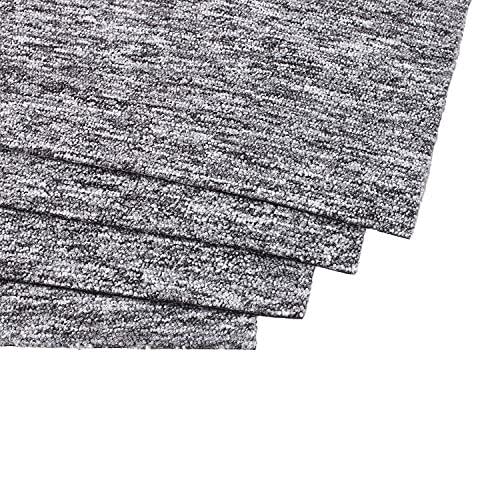
Heavy Duty Carpet Squares (20x20)
amazon.com
$83.69
Courtesy of RetailerBelieve it or not, carpet is probably the most popular flooring option for home gyms. It’s no surprise when you consider how much better the low-key style looks in a home compared to rubber and foam. It’s a far more home-decor-friendly option, but you need to pick the right one. Low pile and synthetic options are reasonable choices, as they leave less breeding ground for bacteria and mold.
Carpet options like Nisorpa’s Heavy Duty Carpet Squares are also soft on the joints, easy to keep clean, and provide great soundproofing. That last feature is important for homes with kids or WFH adults who don’t want to listen to clanging barbells and weight plates from the other side of the house. This flooring is plenty durable and easy to install, and can even be cut to fit (more easily than rubber or vinyl options, too). Carpet generally provides enough traction and stability for cardio equipment, and it will hold up against your heavy weight equipment, too.
On the downside, it offers minimal shock absorption, so it’s not great for floor-based exercises with a ton of jumping. Frequent cleaning is also necessary as the fibers can trap germs and moisture. Unlike foam and rubber, carpet tiles can also stretch over time. Still, at around $2 per square foot, it’s a decent option if you’re looking for the most decorative home gym flooring.
Read more: Best Bike Trainer
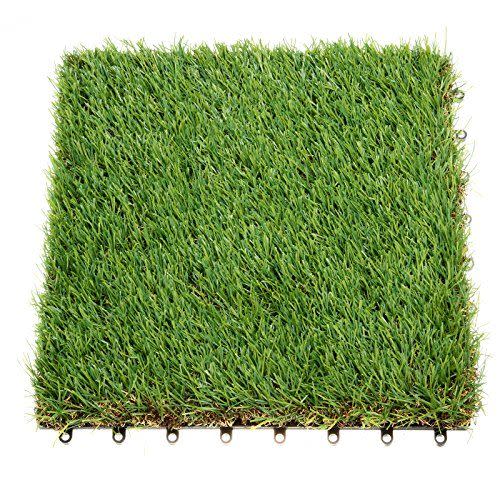
Artificial Grass Interlocking Turf Tile
amazon.com
$33.99
Courtesy of RetailerIf you’re looking to train for outdoor sports, most rubber and foam floor mats aren’t going to cut it. In such cases, artificial turf is the way to go. It’s perfect for athletes who want the ability to add sled pulls and pushes into your strength training while not compromising on traction and resistance for sprints and conditioning. That’s why our go-to home gym flooring option for athletic training is Golden Moon’s Artificial Grass Turf Tile. It won’t dent or crack and is easier to maintain with only occasional brushing and cleaning, so it's also a great option for spaces that get a ton of use.
Great turf flooring basically means you always have a place to bring your outdoor training indoors. The best part though? No mowing.
It’s not perfect, however. For one, it’s more abrasive than most other options which can be a deal-breaker for those who do a lot of floor exercises. The most obvious difference, though, is the price. Most artificial turf tile flooring costs significantly more than rubber and foam options.
Read more: Best Stair Climber

Practice Dance Floor Tiles
amazon.com
$53.75
Courtesy of RetailerMost home gym flooring looks like home gym flooring—it’s all about function over flash. But these wood-look tiles from IncStores can give your home gym a professional look and are suitable for almost any type of exercise. With a handful of grain patterns available, it’s easy to find one that matches your home décor. Plus, thanks to foam-backing, the wood is now more shock-absorbent and fitness-friendly. Don’t let the “Practice Dance” name fool you. This home gym flooring option is perfectly suited for most at-home fitness enthusiasts, provided you’re not setting up a power rack or dropping 500-pound barbells on it on the regular.
That’s because it can scratch and splinter under serious stress. The plastic surface can become slippery when wet too, like with excessive sweat or spilled energy drinks. Thanks to its good looks, it’s also among the most expensive flooring options too. But, for those into aerobic exercise, kickboxing, or dancing like nobody’s watching, a faux wood flooring option can be a stunning addition to any workout space.
Read more: Best Resistance Bands
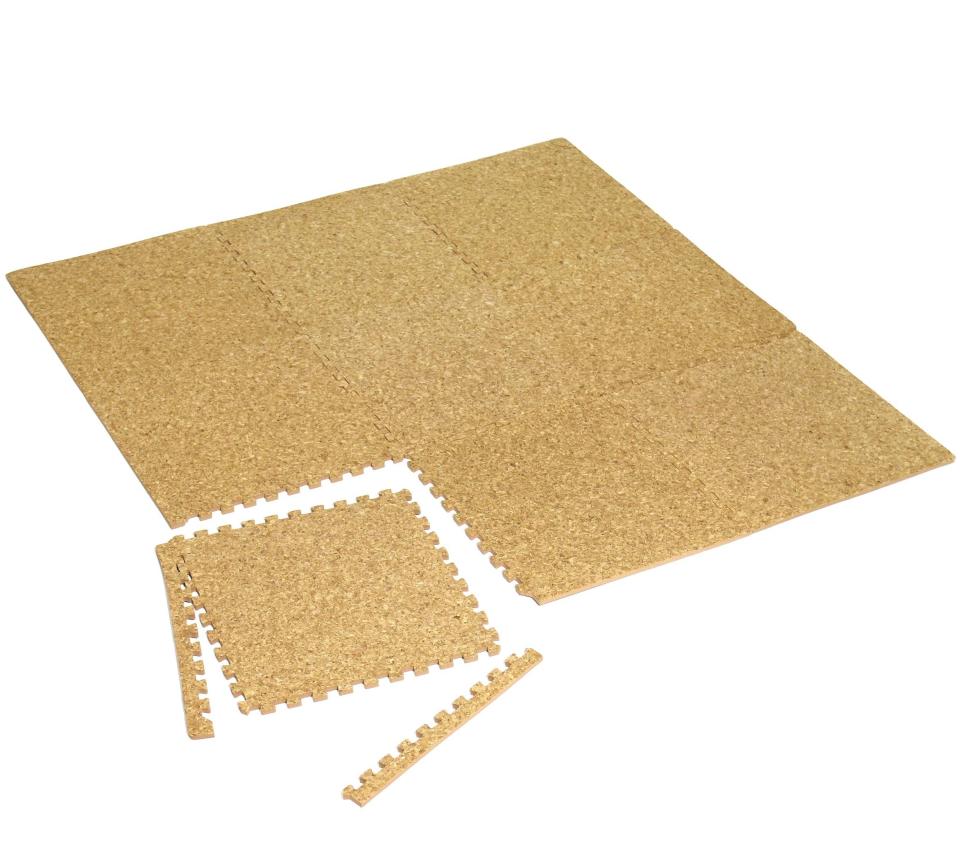
Cork Surface Interlocking Tile Pack
amazon.com
$19.99
Unlike every other option in our roundup, cork is a renewable, fully biodegradable material. So it's an ideal option for the eco exerciser. It’s a natural home gym flooring option that's resistant to shock, fire, mold, mites, and mildew. The flex design of the VViViD interlocking cork tiles is ideal for high-intensity workouts and weight training. These tiles can be floated over any hard, flat subfloor to support heavy loads.
In general, cork flooring is very durable overall, but heavy equipment can leave dents over time as the material is porous. The planks in this collection, specifically, are made from the protective bark of the cork oak tree, which is naturally more resilient to retaining its shape even under heavy compression compared to other cork flooring.
It’s also more prone to fading and drying out from direct sunlight than other materials—something to keep in mind when you’re trying to decide where to setup your home gym. While these tiles are mostly reasonably priced, cork flooring in general tends to be more expensive than rubber and plastic options.
Read more: Best Dumbbells
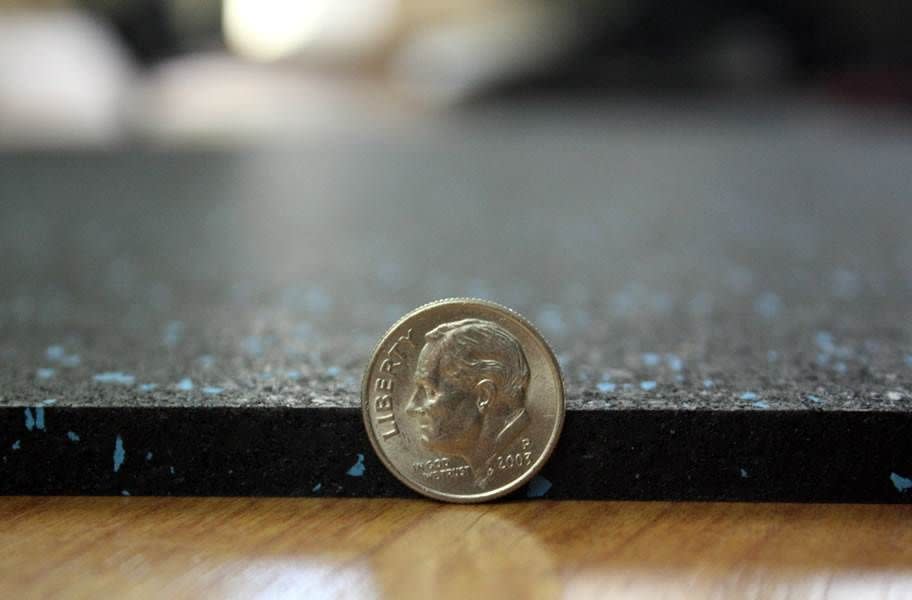
Rubber Flooring Inc. 8mm Strong Rubber Rolls
Rubber Flooring Inc.
$119.55
If you're after the professional look of heavy-duty rubber flooring but are concerned about bringing that gassy rubber smell into your home, Rubber Flooring Inc.'s 8mm Strong Rubber Rolls have got you covered. It's actually what's used in many commercial settings, so you can be confident it'll hold up well under the weight of heavy-duty equipment and cardio machines. They're slightly thinner than the interlocking rubber tiles also on this list, but are solid as an ultra-protective buffer that's not too cushiony.
But what really makes this option different is that it comes in a roll format. The smallest roll sold by the brand is 15-ft x 4-ft, which is great for covering a lot of ground. If your space is much smaller than that or if you need to cut and splice multiple rolls to get the right fit (you probably will), you'll find that cutting heavy-duty rubber is a workout on its own. We won't lie, it's not easy. And you'll likely need to use carpet tape to secure each roll in place to avoid them shifting during use, too. But the solid look and elite feel the Strong Rubber Rolls provide is definitely worth the trouble. At about $2 per sq. ft., it's an economical way of flooring larger spaces.
Read more: Best Adjustable Dumbbells

Rubber Flooring Inc. Turf Tiles
Rubber Flooring Inc.
$2178.00
Here's another great option if you’re looking to train for outdoor sports or general agility, and this one is ideal for large spaces. Rubber Flooring Inc.'s Turf Tiles are a bit thinner in pile height compared some other turf options, but the 1" thickness is effective in both cushioning and durability. These tiles are made from recycled rubber and water-resistant, so you won't need to worry much about mold or mildew. And the interlocking design allows for a user-friendly, easy installation.
As we mentioned earlier, turf is ideal for athletic training as it allows for a balance of traction when you need it and glide when it's necessary. Compared to other materials of flooring, it's helpful in preventing injury and relatively easy to keep up with, too. Occasional cleaning and brushing really shouldn't be ignored though, as stuck on dirt and debris can lead to bacterial growth.
Though turf can be pricey compared to other home gym flooring options, this one comes at a pretty reasonable price tag. Also, it's back by a 1-year warranty.
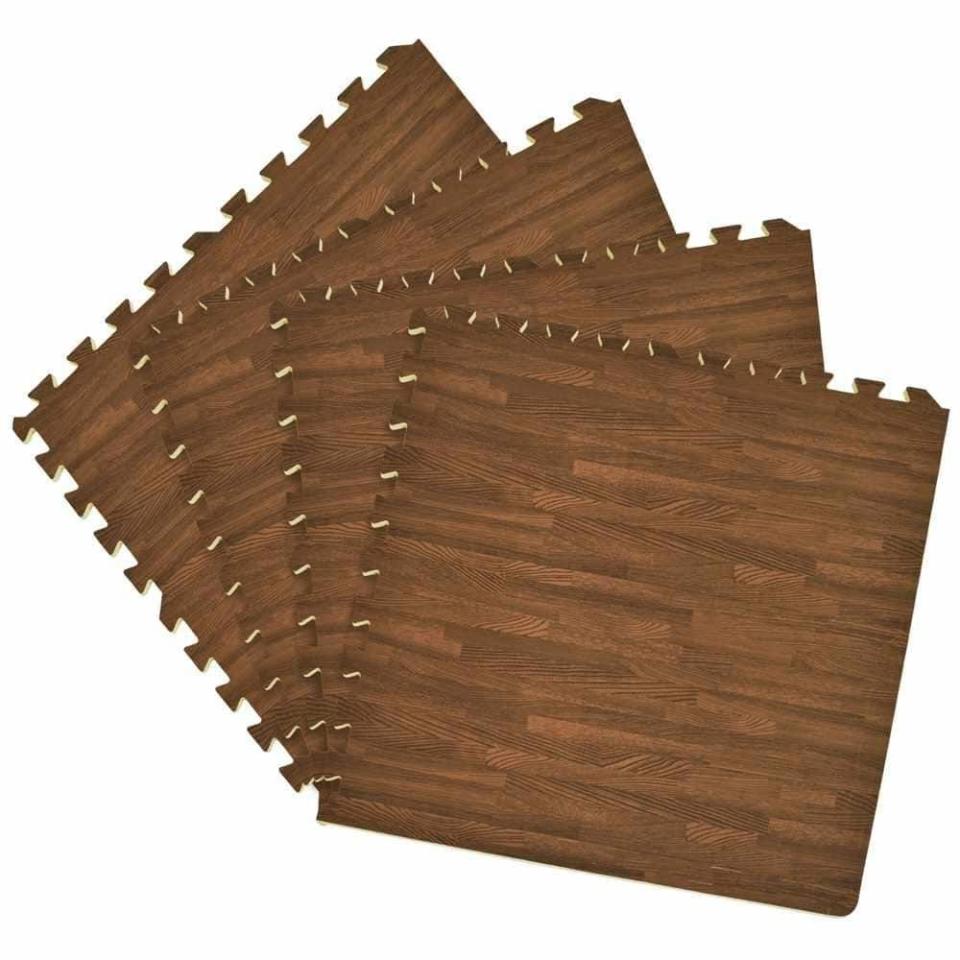
Interlocking Foam Anti Fatigue Tiles
homedepot.com
$17.48
By now you've probably picked up on the pros and cons of foam gym flooring options: they're cushiony and forgiving, but they don't always look great. Not so with ACHIM's Walnut Interlocking Foam Anti Fatigue Tiles, made from durable EVA foam. We're not so sure about the claims that these tiles can reduce fatigue while standing, but we are sure that they do the job of a foam floor and look great doing it.
First and foremost, they're shock absorbent. If you're throwing heavy weight around at home and want to protect the floors you've got underneath, these are a great buffer. They're also easy to install, with an interlocking design that creates a seamless result. Which brings us to another perk of this pick: they're huge. They're 24" x 24" and come in a 4-pack, which means just one pack can cover a 16 square foot area. Though they're not water-resistant, the easy tile format allows for individual sections to be removed, cleaned, dried, or replaced whenever necessary.
How We Selected the Best Home Gym Flooring
There’s an almost infinite number of flooring options for your home gym. That’s why we did the heavy lifting (pun intended) by researching dozens of the most popular and best-reviewed home gym flooring options on the market by comparing every feature, right down to the per-square-foot price. Men's Health fitness editors and experts paid close attention to the most important features, including material, (should you go with synthetic or natural?), format (interlocking tiles, roll, etc.), thickness, installation—you get the picture. Our top picks also took into account verified buyer ratings and reviews from top retailers and other sources we trust. The list above represents our carefully chosen picks of the best home gym flooring options to shop in 2024.
How to Choose the Best Home Gym Flooring Option (for You)
As with shopping for any home flooring, there’s an almost infinite number of options when it comes to flooring options for your home gym too. You’ll find a sea of synthetics like rubber, foam, and wood-look plastic, plus natural options like compressed cork. Whatever type of home gym flooring you’re looking for, there’s a solution for you. Here are a few things to consider before you pull the trigger:
Material: There are a handful of base synthetic materials to choose from for your home gym flooring. Namely: rubber, plastic, foam, or turf. Every synthetic option is typically from one of these materials and they each have their own pros and cons.
Rubber is extremely heavy-duty, easy to install, and washable, so it’s ideal for hardcore workouts. Plastic is the easiest to clean and install as it’s very lightweight, however, that means it’s also more prone to cracking than rubber. Foam is the best home gym flooring option when you want the most cushiony “give” for floor-based workouts (think yoga and Pilates), although it’s not water-resistant. Turf has its place too, especially for outdoor-like workouts. But, it’s typically very expensive and less than ideal for heavy weightlifting.
Thickness: The thickness of the flooring is important because it's what determines the level of impact absorption and cushioning it provides. Generally, thicker flooring is better for activities that involve high-stock activities like jumping and heavy lifting. Your joints will thank you later.
Durability: Your flooring should be able to withstand the weight and impact of your cardio machines, weights, other equipment, and most importantly, your routine. Look for flooring that is designed to withstand heavy use and won't wear down with the type of exercise you engage in.
The type of flooring you choose will largely depend on your fitness routine. If you like intense and aerobic activities like weight training and jumping rope, foam or rubber is your man. As a base for beefy fitness equipment like treadmills, rowing machines, and exercise bikes, you’ll be better off with low-profile vinyl or carpet.
Soundproofing: Some materials offer more noise-dampening than others, which can be important if you’re typically clanging weights or jumping around a lot during your workouts. A thick rubber flooring option is the best way to minimize or even eliminate this. Depending on your setup, you might consider adding extra padding in the areas of your home gym where you’ll be lifting (and potentially dropping) heavy weights.
Budget: The good news is that there are plenty of flooring options (in almost any material) for every budget. Foam is almost always going to be the cheapest, while artificial turf or grass is likely to be the most expensive. Heavy-duty rubber flooring varies widely in price. To add to the confusion, most retailers list their flooring options differently—sometimes by the square foot, sometimes by the roll, and sometimes by the individual tile—so you may need to break out the calculator to make sure that you’re comparing apples to apples.
Ease of Installation: As we've mentioned, all fitness flooring is not created equally. When it comes to installation, this is even more apparent. Some options couldn't be easier to install, like many of the interlocking tiles featured on this list. Other, like those that come in rolls or don't include interlocking teeth to hold them in place, require significantly more labor to lay down.
Style: While functionality is obviously most important to consider, you may also want to consider the aesthetic appeal of your home gym flooring. After all, it's an investment, and you'll want to like the way it looks. Many products are offered in a range of colors or patters to create a space that is both functional and visually appealing.
What Are the Benefits of Home Gym Flooring?
Depending on your current home gym set up, fitness routine, and the type of flooring you opt for, the benefits can be extensive. But regardless of those specifics, the main pull of installing fitness flooring is to safeguard the foundation of the garage, room, or any other at-home workout space. Meaning it's designed to withstand the abuse of a home gym.
It's common knowledge that a loaded barbell is a weighty object and can cause substantial damage to concrete, wood, and other surfaces if dropped, whether intentionally or not. The addition of home gym flooring is a functional way to protect your workout area that wear and tear.
Better yet, it can also minimize the noise generated by dropping heavy weights. If you co-occupy your quarters, live in an apartment, or even have close neighbors, this is a serious bonus. the noise from your workout can be disruptive to others. Therefore, investing in home gym flooring can not only protect your floors but also help you maintain a quieter workout space.
Plus, it can make any home gym look seriously legit.
How Much Should Home Gym Flooring Cost?
Similar to other fitness gear and equipment, the cost of flooring can vary, a lot. Generally, home gym flooring of all materials can range anywhere from around $1.50 to $11.00 per square foot, but heavy-duty, commercial rubber options can cost even more.
Consider your budget and how much you're willing to spend first, then shop around. You may want to invest more in high-quality flooring if you plan to use your home gym frequently, own your home, or have heavy equipment, while a more basic option may suffice for city-dwellers and those without much equipment.
Keep in mind that it's not just the cost of the flooring itself that you should consider, but also the cost of installation if you're not comfortable doing it yourself. Some types of flooring, such as interlocking tiles, can be easily installed, while others may require professional installation or some additional hands on deck.
How Thick Should Home Gym Flooring Be?
The ideal thickness of home gym flooring all boils down to the type of exercise you'll be doing and the equipment being stored and used. Here are some general guidelines:
For bodyweight exercises, yoga, and stretching: A thinner flooring option such as a 1/4" thick foam mat may be sufficient.
For weightlifting: If you're using heavy weights, you'll need a thicker flooring option to absorb the impact. Most weightlifters opt for 3/8" to 1/2" thick rubber or foam to ensure enough shock absorption.
For high-impact exercise: If you'll be doing high-impact cardio exercises like jumping jacks, jump rope, or plyometrics, you'll want a thicker flooring option to protect your joints. A 1/2" to 3/4" thick rubber or foam can provide adequate cushioning and reduce the risk of injury.
For multi-purpose use: If you'll be doing a variety of exercises in your home gym, or don't quite know what you'll be doing, choose for more thickness compared to less. That way, your floor can grow with you by accommodate different types of workouts.
How (and When) to Clean Home Gym Flooring
Cleaning your home gym flooring is an important part of maintaining a hygienic and safe workout environment. Depending on the material of flooring you have in your space, cleaning frequency and method will differ. Generally, the most important thing is to regularly remove any debris or loose dirt from the flooring using a broom or vacuum cleaner. If you're using your home gym frequently, 'regularly' might be once a week or once every two weeks.
If you're working out on rubber or vinyl, it's important to go a step further with cleaning every few months. You can do this by mixing a cleaning solution of warm water with mild detergent or disinfectant in a bucket and giving your flooring a good wipe down. Then use a clean, damp mop or sponge to wipe away the cleaning solution and any dirt or stains that have been lifted.
When it comes to turf or carpet, there's a higher pile. Which means more surface area for dirt and bacteria to hold on to. You can vacuum turf just like you would other materials of flooring, but you won't want to give it a full wash down. It's best to spot clean any areas in need of a little extra TLC on turf, then spray an air-drying disinfectant over the surface to kill bacteria. Because turf and carpet are prone to getting, well, dirtier and smellier, do this 1-3x/month, depending on use.
We've included many easily installable/removable tiles in this list for a few reasons, but one is that they're a breeze to clean. Whether you've got a spill or a stain, most interlocking tile flooring can just be removed in segments for cleaning or replacing.
It's important to note that not all home gym flooring is created equal (even two made of the same material), so it's best to refer to the manufacturer's instructions for specific cleaning recommendations.
What Type of Home Gym Flooring is the Safest?
Safety is obviously key consideration when outfitting a workout space at home. You want to choose a surface that provides adequate traction and cushioning to reduce the risk of slips, falls, and injuries, but that's not too difficult to pivot and move on. When choosing home gym flooring, it's important to consider your specific needs and preferences, as well as the types of exercises you'll be doing. Make sure to choose a material that provides adequate traction, shock absorption, and cushioning to help keep you safe and comfortable during your workouts. The safest option will be the one that is the most conducive to the type of exercise you're doing.
What Type of Home Gym Flooring Lasts the Longest?
A lot of these options aren't cheap, we know. So you want to be sure you're not shelling out for flooring that'll need replacing in the near future. If you're worried about wear and tear, opt for something more heavy-duty like the rubber options on this list. Rubber is one of the most durable options for home gym flooring, as it can withstand the most high-traffic use, and won't dry out over time like foam. It's also resistant to moisture and easy to clean, so you can keep mold and bacteria at bay over time. Vinyl is another durable option for home gym flooring, as it is resistant to scratches, scuffs, and stains. It can also withstand heavy foot traffic and is easy to maintain.
Why You Can Trust Us
At Men's Health, we take great pride in providing our readers with reliable and trustworthy product recommendations. We believe that our readers deserve the best, which is why we always make sure to conduct thorough research and testing before making any recommendations. Our writers and editors are experts in their own right, using their informed opinions to select products and ensuring that our content is of the highest quality.
Our product recommendations are purely editorial, and while we may receive free products to test and review, we only recommend the products we are most impressed by. We never let retailers or public relations contacts dictate our content or product coverage. Which is why you can trust us to provide you with reliable and unbiased product recommendations.
Read More About Our Favorite Home Gym Equipment
Best Home Gym Equipment | 2023 Home Gym Awards | 2024 Fitness Awards | Best Cardio Machines | Best Power Racks for Your Home Gym | Best Squat Racks for Your Home Gym | Best Treadmills | Home Gym Essentials | Best Exercise Bikes
Your dream training space is almost complete. You have state-of-the-art equipment, wall mirrors, a kick-ass stereo system, and your spandex and nipple tank top ready to rock—shh, we won’t tell anyone. But there’s one important thing you’re forgetting that lays the groundwork for any successful sweat sesh: the floor.
The right home gym floor can increase stability, reduce body impact, and boost plyometric power. It will also help keep your subfloor protected from scuffs, scratches, and cracks. When choosing a surface, consider the space, the type of equipment you’ll need, and what exercises you’ll be performing. From rubber to foam to cork to turf and more, here are eight flooring options for your workouts.
You Might Also Like

